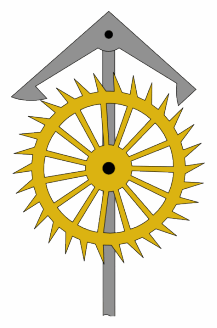Why doesn't my kitchen clock violate thermodynamics?
The pendulum is being driven by the magnet: the fixed magnet in the clock is actually the pole of an electromagnet which the clock is using to drive the pendulum: the clock is putting energy into the pendulum via the electromagnet. Almost certainly the clock 'listens' for the pendulum by watching the induced current in the electromagnet, and then gives it a kick as it has just passed (or alternatively pulls it as it approaches).
People have used techniques like this to actually drive a time-keeping pendulum (I presume this pendulum is not keeping time but just decorative) but I believe they are not as good as you would expect them to be, because the pendulum is effectively not very 'free'. 'Free' is a term of art in pendulum clock design which refers to, essentially, how much the pendulum is perturbed by the mechanism which drives it and/or counts swings, the aim being to make pendulums which are perturbed as little as possible. The ultimate limit of this is clocks where there are two pendulums: one which keeps time and the other which counts seconds to decide when to kick the good pendulum (and the kicking mechanism also synchronises the secondary pendulum), which are called 'free pendulum' clocks.
To answer the question directly - No. Your clock is not violating the Laws of Thermodynamics.
If (as you suspect) the pendulum is purely decorative, then, as tfb states, the fixed magnet is an electromagnet that is being driven by an oscillating current. This provides an oscillating field to kick the pendulum in phase with its swing; same way a dad keeps his kid swinging at the park. Nothing more to it.
On a side note, you mention that the pendulum is not "powering" the clock; it's worth pointing out that pendulums never power clocks. In a classic old Grandfather clock, the power is supplied by descending weights or a coiled-spring which have to be wound up. As it unwinds, it provides a torque to turn the clock mechanism. The purpose of the pendulum is to regulate the rate at which the mechanism turns. It does this by means of an escapement - an ingenious little widget that releases the energy in regular packets. Here is a simple example:

https://commons.wikimedia.org/wiki/File:Anchor_escapement_animation_217x328px.gif
The escapement also gives the pendulum a little kick with every tick (or tock) thus ensuring that it keeps swinging.